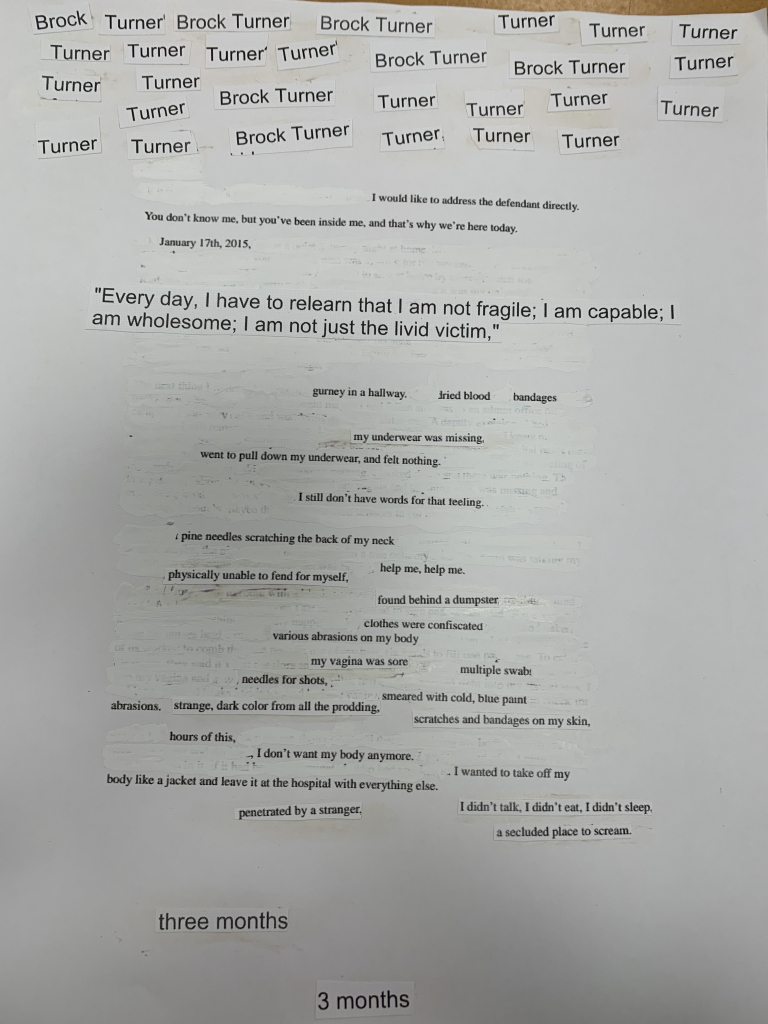By: Marissa Dauber
In the thought provoking and deeply disturbing Citizen: An American Lyric, by Claudia Rankine, we are given countless examples of daily microaggressions that black people face. We are shown situations that may go unnoticed if Rankine hadn’t brilliantly recorded them, and we are made to think differently about how we interact with each other on a daily basis. Rankine reminds us, through real life examples, that our words can hurt and leave lasting effects. However, Rankine also makes mention of some terrible, race-related tragedies that took place, that weren’t so subtle. To name a few, Rankine touches on the murders of Trayvon Martin, James Craig Anderson, and Mark Duggan. She then dedicates an entire page in memoriam to the many black bodies who have died because of their race. She fades the page out while the list is still going to remind the reader that this is a never-ending cycle, and these people frequently end up forgotten about. Perhaps one of the most devastating events Rankine mentions is the tragedy of Hurricane Katrina. Katrina was the most unfair display of blatant racism by police, National guard, and the nation as a whole. Rankine builds her many examples of racism up to this moment: to show that if we ignore racism, continue ignoring microaggressions, and disregard black lives, we will incite a national tragedy. All of our actions and words that may seem small all add up to explode in a nightmare of racially motivated tragedy.
I remember talking about the tragedy of Hurricane Katrina
and it’s disturbing racial ties in a class I took on racism about a year ago.
The professor for the class asked us if we considered Katrina to be a natural
disaster, or a man-made one. The majority of people, including myself, stated
that we thought it was a natural disaster. That was the day I learned the true
meaning behind the events that took place during that hurricane. We watched a documentary
called Trouble the Water, a film created by Kimberly Rivers Roberts and
her husband, Scott Michael Roberts, who experienced life before, during, and
after the storm. In the film, Kimberly states “These houses have not been
inspected yet. There could be dead people right now, as we speak, because the
National Guard, they have not been here, and it’s two weeks after the hurricane”
(Democracy Now, 2008). They were stuck in the attic of their home, hiding from
the water that destroyed the rest of their house. They started walking around
what used to be their neighborhood and going into damaged homes, and they found
their neighbor, dead in his house. The majority of people were too poor to
afford to leave, so they were forced to stay there and die. Later on in the
film, Scott states “This is one of the Navy bases that Bush had planned to
close down. Why can’t we stay overnight? What about the women and children?
They said, “Get off our property, or we’re going to start shooting” “
(Democracy Now, 2008). This scene was so disturbing, because there were safe
and dry places that the people could be staying in, but they were not allowed
to. When they begged to go inside, they were threated to leave or be shot, by
the very people that were hired to “keep them safe”. I was very glad I had this
knowledge of Katrina before reading Rankine’s book. It gave me a different
perspective, as I was able to appreciate Rankine’s artistic and poetic touch to
the tragedy, while understanding the back story behind her words. I feel that
this film and the book couple together so nicely and give such strong
background to the pain these people experienced unnecessarily.
In Rankine’s description of the tragedy, she states “…each
house was a mumbling structure, all that water, buildings peeling apart, the
yellow foam, the contaminated drawl of mildew, mold…the bodies lodged in piles
of rubble, dangling from rafters, lying facedown, arms outstretched on parlor floors.
And someone said, where were the buses? And simultaneously someone else said,
FEMA said it wasn’t safe to be there” (Rankine, 84). This imagery says all too
well what Katrina was like for black people. The very people that are hired and
paid to protect them wouldn’t come to their rescue because “it wasn’t safe”,
but they left all the people there to die, knowing it wasn’t safe. Rankine
keeps repeating “Have you seen their faces?” (Rankine 83, 85-86) which
emphasizes the point she previously made with the list of names fading off the
page: these people will be forgotten about. They already are.
Rankine’s telling of the tragedy of Hurricane Katrina,
coupled with the documentary Trouble the Water, really gave me a new
perspective to this disaster, and taught me a lesson I will never forget:
Hurricane Katrina was a man-made disaster. Humankind must change. Our daily
acts of racism in the form of microaggressions add up until they explode, just
as what happened in the man-made disaster of Hurricane Katrina. How many black
bodies must fall until we change our ways?
Discussion Questions
- How did reading Citizen: An American
Lyric give you a new perspective on Hurricane Katrina?
- What example of racism affected you/stood
out to you most from this book?
Works
Cited
Rankine, Claudia, 1963- author. Citizen: An American Lyric. Minneapolis, Minnesota: Graywolf Press, 2014.
“‘Trouble
the Water’–New Film Provides Firsthand Account of Hurricane Katrina and Its
Aftermath.” Democracy Now!, 22 Aug. 2008, https://www.democracynow.org/2008/8/22/trouble_the_water_new_film_provides.

